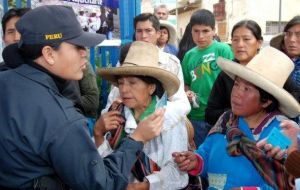MercoPress. South Atlantic News Agency
Humala and Keiko will have to convince the 45% middle of the road vote
 Kuczynski, Toledo and Castañeda voters, the prize to conquer
Kuczynski, Toledo and Castañeda voters, the prize to conquer With 90% of Sunday’s presidential election ballots counted Peru is headed for a runoff between nationalist Ollanta Humala and former lawmaker Keiko Fujimori, a choice many voters in the country’s surging middle and upper classes might have trouble swallowing.
The latest count has the former Army officer Humala with 31.37% of the vote, compared to Fujimori's 23.22% and Pedro Pablo Kuczynski's 19.23%. The former Prime Minister and Finance minister in third place had not officially conceded as of Monday but admitted that the runoff would be between Humala and Fujimori.
Julio Carrion, a Peruvian professor of political science at the University of Delaware argues that the run-off “sounds like a terrible choice” for many voters, given the fact that 45% of the vote cast in the election are centre right positions.
Carrion arrives at this conclusion by adding the votes from the apparent third-, fourth- and fifth-place finishers -- Kuczynski, former President Alejandro Toledo and former Lima Mayor Luis Castañeda, with “virtually indistinguishable center-right positions”.
Peruvian writer and Nobel Prize laureate Mario Vargas Llosa has characterized the choice between them as a choice between cancer and AIDS, state news reports.
Humala appeared a threat to the market-oriented economic policies embraced by the country for decades. And Fujimori worried people with pronouncements that she would pardon her father, former President Alberto Fujimori, who is serving a 25-year sentence for human rights abuses.
Both candidates have softened or backtracked on these controversial positions since then. Humala has been careful to be identified and have pictures taken with Brazil’s Lula da Silva and current president Dilma Rousseff, and has abandoned the red shirt for suits and tie.
Humala of indigenous roots became famous in 2000 for leading an aborted military rebellion against then President Alberto Fujirmori. He has been accused of human rights abuses when as a captain he fought the Shinning Path rebels in the nineties. After leaving jail he majored in political science.
Nevertheless Humala, who lost in the second round of the 2006 elections, will have a hard time convincing people that he is not the Hugo Chavez ally that his critics have made him out to be. Humala has said that he has matured, and his choices for advisers show that his moderation may be sincere, Carrion said.
For Carrion, “Keiko will have an easier time convincing people to vote for her in the run-off next June 5“.
Concerns about Fujimori, who at 19 served as the nation's first lady, include whether she will have an authoritarian streak like her father and will allow corruption and have dealings with unsavory characters, as her father did. She did not apologize for her father’s coup in 1992 when he closed Congress and sacked judges.
Besides those fears, Fujimori's policies are not unlike those of the middle three candidates, Carrion said.
She was the most voted Lower House member in 2006 but has a record of absences to the House, 500.
However Eurasia analyst Erasto Almeida believes Humala will have the upper hand in the second round. He should benefit from a strong desire among voters for change.
”First, he would make a more convincing case that he represents the 'change' that most Peruvians want” and secondly most voters have a negative recall of (Fujimori's) father's government.
Almeida added, “If Humala wins he will try to balance his desire to increase the role of the state in the economy without compromising macroeconomic stability, something that could prove challenging.”
Peru can expect growth of 7% this year, according to the World Bank, and is one of the fastest-growing economies in Latin America. The country came through the global financial crisis relatively unharmed, maintaining GDP growth, employment creation and poverty reduction, according to Peru's Ministry of Economy and Finance.
This has created high expectations from Peruvians, who want to see the rewards of this progress in tangible ways. While the economy as a whole has done well, salaries have remained depressed during the same period and although Peru has witnessed a sizable decrease in poverty over the past decade, it still stands at about 35%.




Top Comments
Disclaimer & comment rulesCommenting for this story is now closed.
If you have a Facebook account, become a fan and comment on our Facebook Page!